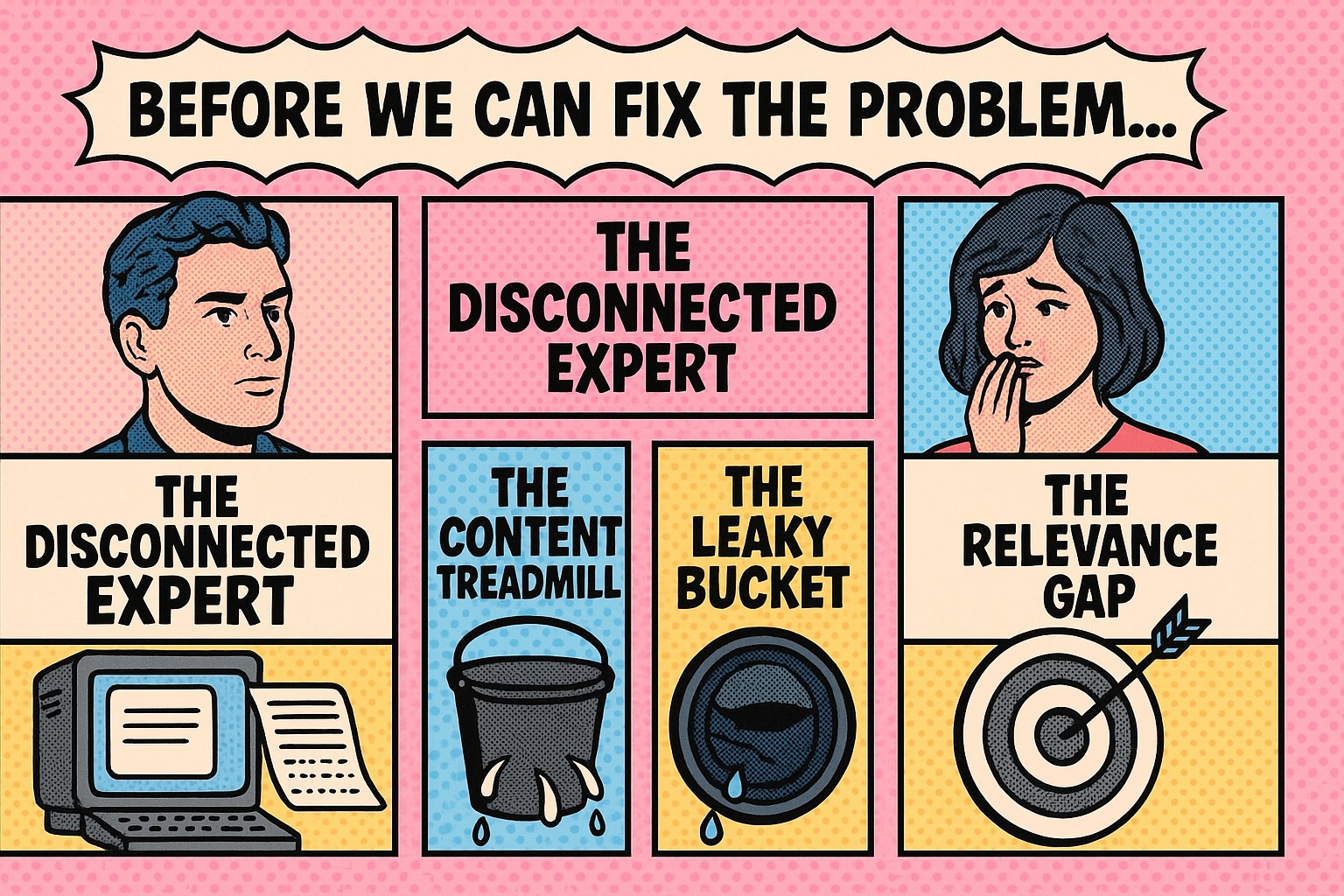The 'Content-to-Conversion' Audit: How to Turn Your Blog Traffic into Trial Users
Your blog's getting traffic like a busy motorway, but conversions are more like a Sunday stroll through a ghost town. Time to stop admiring your visitor stats and start turning those browsers into actual trial users who might—shock horror—pay you.
From Content Churners to Conversion Champions: The Art of Actually Making Money from Your Blog
Let's be honest: we've all spent hours crafting the "perfect" blog post only to watch it collect digital dust while our trial sign-up metrics flatline. Your analytics show thousands of visitors devouring your content, yet your actual conversion numbers suggest they're all just stopping by for a quick intellectual snack before disappearing forever. It's the digital equivalent of someone coming to your house, eating all your fancy cheese, and leaving without so much as a thank you note. And yes, we've all been there.
The Great Content Delusion
I used to believe that exceptional content would automatically translate to exceptional conversion rates. Write it and they will come... and stay... and pay. The reality? I've watched beautifully crafted 3,000-word masterpieces generate absolutely nothing beyond fleeting social media praise. The truth is, most of us are running content museums, not conversion machines.
Content without conversion strategy is just expensive philanthropy. You're essentially running a free library while paying for all the books, the building, and the librarians. (And unlike actual libraries, you don't even get government funding.)
The disconnect typically happens because we've been fed the "content is king" line without the crucial addendum: "but conversion is the kingdom." Your blog isn't just a publication—it's the top of your sales funnel, even if that makes you squirm a bit to admit it.
Diagnosing Your Blog's Conversion Illness

Before we can fix the problem, we need proper diagnosis. Most blogs suffer from one of several conversion pathologies, each requiring different treatment:
- The Disconnected Expert: Your content establishes tremendous authority but never actually mentions your product.
- The Bashful Salesperson: You hint at your solution but are too afraid to make the proper connection for fear of seeming "salesy."
- The Content Treadmill: You're creating endless content with no strategic funnel or purpose.
- The Leaky Bucket: Your content attracts visitors, but your site lacks proper conversion architecture to capture them.
- The Relevance Gap: The audience reading your blog posts isn't actually the same audience who would buy your product.
The first step in your audit should be identifying which of these afflictions is plaguing your blog. In my case, I spent months writing thought leadership pieces that made me sound brilliant but never actually told people what I sold. I was essentially running a free consulting service via my blog while wondering why my business was struggling. Maddening, in retrospect.
The Content-to-Conversion Audit Framework
Right, let's get practical. Here's the audit framework I wish someone had given me before I wasted a year's worth of content marketing effort. This isn't just theory—it's the result of painful, expensive lessons learned the hard way.
First, you need to conduct a proper audit of your current content-to-conversion pipeline. This means tracking:
- Blog-specific conversion rate (total trial sign-ups directly from blog pages divided by total blog visitors)
- Top entry pages vs. top converting pages (often shockingly different)
- Average time on site for converted vs. non-converted visitors
- The number of pages viewed before conversion
- Scroll depth on high-traffic pages that aren't converting
The patterns will tell you where the breakdown is happening. When I finally did this analysis, I discovered people were reading my entire articles but then simply leaving because I'd given them no compelling next step. I'd satiated their curiosity without creating desire for more. Classic content marketing malpractice.
Building Your Content-to-Conversion Pipeline
After running this audit with dozens of SaaS companies, I've identified five critical components of a functioning content conversion system:
- Strategic relevance mapping: Each piece of content must connect to a specific pain point your product solves
- Contextual CTAs: Not generic "Sign up!" buttons but problem-specific offers that naturally extend from the article's topic
- Content segmentation paths: Ways for readers to self-identify their specific problem and get guided to relevant solutions
- Value demonstration opportunities: Interactive elements that showcase your product's value without requiring signup
- Progression architecture: A clear next step for every piece of content that moves readers closer to conversion
Let me confess something embarrassing: For my first business, I spent six months writing blog posts without a single email capture form. Not one. I was essentially shouting into the void, then wondering why the void wasn't buying my products. Don't be like past me. Build the infrastructure that captures the interest you're generating.
This is where understanding how to build a comprehensive content funnel becomes essential. A single well-structured pillar page can serve as the hub of your entire conversion system, with supporting content that guides readers through each stage of the buying journey.
The Conversion Content Matrix
Not all content has the same conversion potential, and that's perfectly fine—if you plan for it. I categorise content into four types, each with different conversion expectations:
1. Discovery Content: High-traffic, low-conversion pieces that capture broader audiences. These should focus on email capture rather than direct trial conversion.
2. Consideration Content: Mid-funnel content that speaks to specific problems your product solves. This should have moderate conversion expectations and stronger product connections.
3. Conversion Content: Direct problem-solution content that naturally leads to your product. This should have high conversion expectations.
4. Retention Content: Content for existing customers that drives deeper usage and reduces churn. This converts users from basic to power users.
The common mistake is treating all content the same way or, worse, only creating discovery content and wondering why it doesn't convert. Your content matrix should have intentional distribution across all four categories.
Here are five practical tweaks you can implement this week to start converting more blog readers:
- Add solution-aware CTAs at crucial points in your top 5 traffic-generating blog posts (after identifying pain, before providing the complete solution)
- Create a "Start Here" page that segments visitors based on their specific problems and guides them to relevant solutions
- Add social proof elements specifically related to the topic of each high-traffic post (not generic testimonials)
- Implement content upgrades specific to each popular post rather than generic lead magnets
- Add a "See How [Product] Solves This" section at the end of problem-focused articles with a direct link to the relevant feature
Measuring What Matters
The final piece of this puzzle is proper measurement. Stop obsessing over pageviews and start tracking what I call "conversion momentum metrics":
Content Conversion Rate: The percentage of blog readers who become trial users, measured both by entry page and by last-touch page.
Content Value: The average revenue generated per 1,000 views of each piece of content.
Conversion Path Clarity: The percentage of visitors who take a deliberate next step from your content (rather than bouncing or hitting random navigation).
Content-Qualified Leads: Readers who consume specific combinations of content that indicate high purchase intent.
When I finally started tracking these metrics instead of vanity pageviews, the entire focus of our content strategy shifted. We started producing less content but driving more conversions. We worked smarter, not harder—a novel concept in content marketing, apparently.
The greatest irony I've found is that being more intentional about conversion often creates better content. When you're crystal clear about how a piece fits into your conversion architecture, you focus more tightly on solving specific problems rather than creating vague, catch-all content that helps no one in particular.
The Human Element
There's something almost uncomfortable about treating blog readers as potential customers rather than just an audience. It feels a bit mercenary. But here's the perspective shift that helped me: If your product genuinely solves the problems your content addresses, then not connecting those dots is actually a disservice to your readers.
Your blog readers aren't just content consumers—they're people with problems looking for solutions. Sometimes the solution is just information, but often they need tools, systems, or services to implement what they've learned. If you're not offering a pathway to those solutions (assuming your product is one), you're actually leaving them with half a solution.
This perspective transformed how I approached content. I stopped seeing conversion as something I was doing to readers and started seeing it as something I was doing for them. Understanding your audience better is crucial here—implementing strategic social listening can reveal the real problems your audience faces. Research shows that 71% of consumers who have a positive brand experience on social media are likely to recommend it to others, proving that monitoring and engaging with these conversations creates measurable business impact.
I remember the moment this clicked. I was looking at analytics showing thousands of people reading an article about a problem my product directly solved—yet they were leaving without ever knowing the solution existed. I wasn't being humble; I was being negligent.
The content-to-conversion pipeline isn't just good business; it's good service. When built with integrity, it creates a virtuous cycle where your best content attracts your ideal customers, your product delivers on the promises your content makes, and your business grows as a result.
Let's stop creating content that doesn't convert and stop being surprised when readers don't magically discover our products. The gap between reading and buying doesn't bridge itself. It's on us to build that bridge—carefully, ethically, but also deliberately.
After all, the best content in the world is worthless if it doesn't ultimately help the humans it was created to serve. And sometimes, helping means more than just informing—it means guiding them to solutions that actually change their situation. Even if that solution happens to pay your bills.






